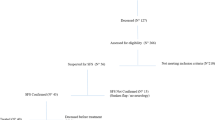Abstract
Sinking skin flap syndrome is a craniectomy complication characterized by new neurological dysfunction that typically worsens in the upright position and improves after cranioplasty. We present a 33-year-old man who experienced hemiparesis in the upright position after craniectomy. Upright computed tomography (CT) before cranioplasty showed a remarkable shift of the brain compared to supine CT. After cranioplasty, both symptoms and brain shift on CT resolved. Upright CT enables detection and objective evaluation of paradoxical herniation and midline shift that is not obvious on supine imaging modalities. Clinicians need to be aware of positional brain shift in postcraniectomy patients.


Similar content being viewed by others
Data availability
Not applicable.
Code availability
Not applicable.
Abbreviations
- CSF:
-
Cerebrospinal fluid
- CT:
-
Computed tomography
- ICP:
-
Intracranial pressure
- SSFS:
-
Sinking skin flap syndrome
References
Andresen M, Juhler M (2014) Intracranial pressure following complete removal of a small demarcated brain tumor: a model for normal intracranial pressure in humans. J Neurosurg 121:797–801
Annan M, De Toffol B, Hommet C, Mondon K (2015) Sinking skin flap syndrome (or syndrome of the trephined): a review. Br J Neurosurg 29:314–318
Ashayeri K, Jackson EM, Huang J, Brem H, Gordon CR (2016) Syndrome of the trephined: a systematic review. Neurosurgery 79:525–534
Di Rienzo A, Colasanti R, Gladi M, Pompucci A, Della Costanza M, Paracino R, Esposito D, Iacoangeli M (2020) Sinking flap syndrome revisited: the who, when and why. Neurosurg Rev 43:323–335
Epstein HM, Linde HW, Crampton AR, Ciric IS, Eckenhoff JE (1970) The vertebral venous plexus as a major cerebral venous outflow tract. Anesthesiology 32:332–337
Grant FC, Norcross NC (1939) Repair of cranial defects by cranioplasty. Ann Surg 110:488–512
Holmlund P, Johansson E, Qvarlander S, Wahlin A, Ambarki K, Koskinen LD, Malm J, Eklund A (2017) Human jugular vein collapse in the upright posture: implications for postural intracranial pressure regulation. Fluids Barriers CNS 14:17
Jinzaki M, Yamada Y, Nagura T, Nakahara T, Yokoyama Y, Narita K, Ogihara N, Yamada M (2020) Development of upright computed tomography with area detector for whole-body scans: phantom study, efficacy on workflow, effect of gravity on human body, and potential clinical impact. Invest Radiol 55:73–83
Lim J, Kwon HJ, Kim SH, Koh HS, Choi SW (2018) Early occurrence of sinking skin flap syndrome in a state of intracranial hypertension : case report. Clin Neuroradiol 28:297–300
Magnaes B (1976) Body position and cerebrospinal fluid pressure. Part 2: clinical studies on orthostatic pressure and the hydrostatic indifferent point. J Neurosurg 44:698–705
Monea AG, Verpoest I, Vander Sloten J, Van der Perre G, Goffin J, Depreitere B (2012) Assessment of relative brain-skull motion in quasistatic circumstances by magnetic resonance imaging. J Neurotrauma 29:2305–2317
Petersen LG, Lawley JS, Lilja-Cyron A, Petersen JCG, Howden EJ, Sarma S, Cornwell WK 3rd, Zhang R, Whitworth LA, Williams MA, Juhler M, Levine BD (2019) Lower body negative pressure to safely reduce intracranial pressure. J Physiol 597:237–248
Petersen LG, Ogoh S (2019) Gravity, intracranial pressure, and cerebral autoregulation. Physiol Rep 7:e14039
Petersen LG, Petersen JC, Andresen M, Secher NH, Juhler M (2016) Postural influence on intracranial and cerebral perfusion pressure in ambulatory neurosurgical patients. Am J Physiol Regul Integr Comp Physiol 310:R100–R104
Schnaudigel S, Preul C, Ugur T, Mentzel HJ, Witte OW, Tittgemeyer M, Hagemann G (2010) Positional brain deformation visualized with magnetic resonance morphometry. Neurosurgery 66:376–384
Stiver SI, Wintermark M, Manley GT (2008) Reversible monoparesis following decompressive hemicraniectomy for traumatic brain injury. J Neurosurg 109:245–254
Stok WJ, Karemaker JM, Berecki-Gisolf J, Immink RV, van Lieshout JJ (2019) Slow sinusoidal tilt movements demonstrate the contribution to orthostatic tolerance of cerebrospinal fluid movement to and from the spinal dural space. Physiol Rep 7:e14001
Valdueza JM, von Munster T, Hoffman O, Schreiber S, Einhaupl KM (2000) Postural dependency of the cerebral venous outflow. Lancet 355:200–201
Vasung L, Hamard M, Soto MCA, Sommaruga S, Sveikata L, Leemann B, Vargas MI (2016) Radiological signs of the syndrome of the trephined. Neuroradiology 58:557–568
Yamada Y, Yamada M, Yokoyama Y, Tanabe A, Matsuoka S, Yuki Niijima KN, Nakahara T, Murata M, Fukunaga K, Chubachi S, Jinzaki M (2020) Differences in lung and lobe volumes between supine and standing positions scanned with conventional and newly developed 320-detector-row upright CT: intra-individual comparison. Respiration https://doi.org/10.1159/000507265
Yamaura A, Makino H (1977) Neurological deficits in the presence of the sinking skin flap following decompressive craniectomy. Neurol Med Chir (Tokyo) 17:43–53
Acknowledgments
The authors would like to thank Enago (www.enago.jp) for the English language review.
Author information
Authors and Affiliations
Contributions
All authors contributed to the study conception and design. Material preparation, data collection, and analysis were performed by all authors. The first draft of the manuscript was written by Keisuke Yoshida, and all authors commented on previous versions of the manuscript. All authors read and approved the final manuscript.
Corresponding author
Ethics declarations
Conflict of interest
The authors declare that they have no conflict of interest.
Ethical approval
Approval was obtained from the ethics committee of Keio University School of Medicine. The procedures used in this study adhere to the tenets of the Declaration of Helsinki.
Informed consent
The patient consented to the submission of the case report to the journal.
Additional information
Publisher’s note
Springer Nature remains neutral with regard to jurisdictional claims in published maps and institutional affiliations.
This article is part of the Topical Collection on Neurosurgery general
Rights and permissions
About this article
Cite this article
Yoshida, K., Toda, M., Yamada, Y. et al. Sinking skin flap syndrome visualized by upright computed tomography. Acta Neurochir 162, 1825–1828 (2020). https://doi.org/10.1007/s00701-020-04459-7
Received:
Accepted:
Published:
Issue Date:
DOI: https://doi.org/10.1007/s00701-020-04459-7




